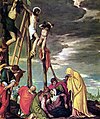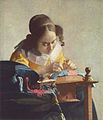Collection
The Musée du Louvre contains more than 380,000 objects and displays 35,000 works of art in eight curatorial departments.[38]
[edit] Egyptian antiquities
The department, comprising over 50,000 pieces,[39] includes artifacts from the Nile civilizations which date from 4,000 BCE to the 4th century CE.[40] The collection, among the world's largest, overviews Egyptian life spanning Ancient Egypt, the Middle Kingdom, the New Kingdom, Coptic art, and the Roman, Ptolemaic, and Byzantine periods.[40] The department's origins lie in the royal collection, but it was augmented by Napoleon's 1798 expeditionary trip with Dominique Vivant, the future director of the Louvre.[39] After Jean-François Champollion translated the Rosetta Stone, Charles X decreed that an Egyptian Antiquities department be created. Champollion advised the purchase of three collections, the Durand, Salt and Drovetti; these additions added 7,000 works. Growth continued via acquisitions by Auguste Mariette, founder of the Egyptian Museum in Cairo. Mariette, after excavations at Memphis, sent back crates of archaeological finds including The Seated Scribe.[39][41]
Guarded by the Large Sphinx (c. 2000 BCE), the collection is housed in more than 20 rooms. Holdings include art, papyrus scrolls, mummies, tools, clothing, jewelry, games, musical instruments, and weapons.[39][40] Pieces from the ancient period include the Gebel-el Arak knife from 3400 BCE, The Seated Scribe, and the Head of King Djedefre. Middle Kingdom art, "known for its gold work and statues", moved from realism to idealization; this is exemplified by the schist statue of Amenemhatankh and the wooden Offering Bearer. The New Kingdom and Coptic Egyptian sections are deep, but the statue of the goddess Nephthys and the limestone depiction of the goddess Hathor demonstrate New Kingdom sentiment and wealth.[40][41]

[edit] Near Eastern antiquities
Near Eastern antiquities, the second newest department, dates from 1881 and presents an overview of early Near Eastern civilization and "first settlements", before the arrival of Islam. The department is divided into three geographic areas: the Levant, Mesopotamia, and Iran. The collection's development corresponds to archaeological work such as Paul-Émile Botta's 1843 expedition to Khorsabad and the discovery of Sargon II's palace.[40][42] These finds formed the basis of the Assyrian museum, the precursor to today's department.[40]
The museum contains exhibits from Sumer and the city of Akkad, with monuments such as the Prince of Lagash's Stele of the Vultures from 2,450 BCE and the stele erected by Naram-Suen, King of Akkad, to celebrate a victory over barbarians in the Zagros Mountains. The 2.25-metre (7.38 ft) Code of Hammurabi, discovered in 1901, displays Babylonian Laws prominently, so that no man could plead their ignorance. The Iranian portion contains work from the archaic period, like the Funerary Head and the Persian Archers of Darius I.[40][43]

[edit] Greek, Etruscan, and Roman
The Greek, Etruscan, and Roman department displays pieces from the Mediterranean Basin dating from the Neolithic to the 6th century CE.[44] The collection spans from the Cycladic period to the decline of the Roman Empire. This department is one of the museum's oldest; it began with appropriated royal art, some of which was acquired under Francis I.[40][45] Initially, the collection focused on marble sculptures, such as the Venus de Milo. Works such as the Apollo Belvedere arrived during the Napoleonic Wars, but these pieces were returned after Napoleon I's fall in 1815. In the 19th century, the Louvre acquired works including vases from the Durand collection, bronzes such as the Borghese Vase from the Bibliothèque nationale.[37][44]
The archaic is demonstrated by jewellery and pieces such as the limestone Lady of Auxerre, from 640 BCE; and the cylindrical Hera of Samos, circa 570–560 BCE.[46][40] After the 4th century BCE, focus on the human form increased, exemplified by the Borghese Gladiator. The Louvre holds masterpieces from the Hellenistic era, including The Winged Victory of Samothrace (190 BCE) and the Venus de Milo, symbolic of classical art.[45] In the galleries paralleling the Seine, much of the museum's Roman sculpture is displayed.[44] The Roman portraiture is representative of that genre; examples include the portraits of Agrippa and Annius Verus; among the bronzes is the Greek Apollo of Piombino.
[edit] Islamic art
The Islamic art collection, the museum's newest, spans "thirteen centuries and three continents".[47] These exhibits, comprising ceramics, glass, metalware, wood, ivory, carpet, textiles, and miniatures, include more than 5,000 works and 1,000 shards.[48] Originally part of the decorative arts department, the holdings became separate in 2003. Among the works are the Pyxide d'al-Mughira, a 10th century CE ivory box from Andalusia; the Baptistery of Saint-Louis, an engraved brass basin from the 13th or 14 century Mamluk period; and the 10th century Shroud of Josse from Iran.[47][42] The collection contains three pages of the Shahnameh, an epic poem by Ferdowsi in Persian, and a Syrian metalwork named the Barberini Vase.[48]
[edit] Sculpture
The sculpture department comprises work created before 1850 that does not belong in the Etruscan, Greek, and Roman department.[49] The Louvre has been a repository of sculpted material since its time as a palace; however, only ancient architecture was displayed until 1824, except for Michelangelo's Dying Slave and Rebellious Slave.[50] Initially the collection included only 100 pieces, the rest of the royal sculpture collection being at Versailles. It remained small until 1847, when Léon Laborde was given control of the department. Laborde developed the medieval section and purchased the first such statues and sculptures in the collection, King Childebert and stanga door, respectively.[50] The collection was part of the Department of Antiquities but was given autonomy in 1871 under Louis Courajod, a director who organized a wider representation of French works.[49][50] In 1986, all works from after 1850 were relocated to the new Musée d'Orsay. The Grand Louvre project separated the department into two exhibition spaces; the French collection is displayed in the Richelieu wing, and foreign works in the Denon wing.[49]
The collection's overview of French sculpture contains Romanesque works such as the 11th century Daniel in the Lions' Den and the 12th century Virgin of Auvergne. In the 16th century, Renaissance influence caused French sculpture to become more restrained, as seen in Jean Goujon's bas-reliefs, and Germain Pilon's Descent from the Cross and Resurrection of Christ. The 17th and 18th centuries are represented by Étienne Maurice Falconet's Woman Bathing and Amour menaçant and François Anguier's obelisks. Neoclassical works includes Antonio Canova's Psyche Revived by Cupid's Kiss (1787).[50]
[edit] Decorative arts
The decorative arts' collection spans from the Middle Ages to the mid-19th century. The department began as a subset of the sculpture department, based on royal property and the transfer of work from the Basilique Saint-Denis, the burial ground of French monarchs that held the Coronation Sword of the Kings of France.[51][52] Among the budding collection's most prized works were pietre dure vases and bronzes. The Durand collection's 1825 acquisition added "ceramics, enamels, and stained glass", and 800 pieces were given by Pierre Révoil. The onset of Romanticism rekindled interest in Renaissance and Medieval artwork, and the Sauvageot donation expanded the department with 1,500 middle-age and faïence works. In 1862, the Campana collection added gold jewelry and maiolicas, mainly from the 15th and 16th centuries.[52][53]
The works are displayed on the Richelieu Wing's first floor and in the Apollo Gallery, named by the painter Charles Le Brun, who was commissioned by Louis XIV (the Sun King) to decorate the space in a solar theme. The medieval collection contains the coronation crown of Louis XIV, Charles V's sceptre, and the 12th century porphyry vase.[54] The Renaissance art holdings include Giambologna's bronze Nessus and Deianira and the tapestry Maximillian's Hunt.[51] From later periods, highlights include Madame de Pompadour's Sèvres vase collection and Napoleon III's apartments.[51]

[edit] Painting
The painting collection has more than 6,000 works from the 13th century to 1848 and is managed by 12 curators who oversee the collection's display. Nearly two-thirds are by French artists, and more than 1,200 are Northern European. The Italian paintings compose most of the remnants of Francis I and Louis XIV's collections, others are unreturned artwork from the Napoleon era, and some were bought.[55][56] The collection began with Francis, who acquired works from Italian masters such as Raphael and Michelangelo,[57] and brought Leonardo da Vinci to his court.[9][58] After the French Revolution, the Royal Collection formed the nucleus of the Louvre. When the d'Orsay train station was converted into the Musée d'Orsay in 1986, the collection was split, and pieces completed after the 1848 Revolution were moved to the new museum. French and Northern European works are in the Richelieu wing and Cour Carrée; Spanish and Italian paintings are on the first floor of the Denon wing.[56]
Exemplifying the French School are the early Avignon Pieta of Enguerrand Quarton; Jean Fouquet's King Jean le Bon, the oldest independent portrait in Western painting to survive from the postclassical era;[59] Hyacinthe Rigaud's Louis XIV; Jacques-Louis David's The Coronation of Napoleon; and Eugène Delacroix's Liberty Leading the People. Northern European works include Johannes Vermeer's The Lacemaker and The Astronomer; Caspar David Friedrich's Tree of Crows; Rembrandt's The Supper at Emmaus, Bathsheba at Her Bath, and The Slaughtered Ox.
The Italian holdings are notable, particularly the Renaissance collection. The works include Andrea Mantegna and Giovanni Bellini's Calvarys, which reflect realism and detail "meant to depict the significant events of a greater spiritual world".[60] The High Renaissance collection includes Leonardo da Vinci's Mona Lisa, Virgin and Child with St. Anne, St. John the Baptist, and Madonna of the Rocks. Caravaggio is represented by The Fortune Teller and Death of the Virgin. From 16th century Venice, the Louvre displays Titian's Le Concert Champetre, The Entombment and The Crowning with Thorns.[61][62]

[edit] Prints and drawings
The prints and drawings department encompasses works on paper.[63] The origins of the collection were the 8,600 works in the Royal Collection (Cabinet du Roi), which were increased via state appropriation, purchases such as the 1,200 works from Fillipo Baldinucci's collection in 1806, and donations.[37][64] The department opened on 5 August 1797, with 415 pieces displayed in the Galerie d'Apollon. The collection is organized into three sections: the core Cabinet du Roi, 14,000 royal copper printing-plates, and the donations of Edmond de Rothschild, which include 40,000 prints, 3,000 drawings, and 5,000 illustrated books. The holdings are displayed in the Pavillon de Flore; due to the fragility of the paper medium, only a portion are displayed at one time.[63]
[edit] Satellite museums
[edit] Lens
In 2004, French officials decided to build a satellite museum on the site of an abandoned coal pit in the former mining town of Lens to relieve the crowded Paris Louvre, increase total museum visits, and improve the industrial north's economy.[65] Six cities were considered for the project: Amiens, Arras, Boulogne-sur-Mer, Calais, Lens, and Valenciennes. In 2004, French Prime Minister Jean-Pierre Raffarin chose Lens to be the site of the new building, called Le Louvre-Lens. Museum officials predicted that the new building, capable of receiving about 600 works of art, would attract up to 500,000 visitors a year when it opened in 2009.[65]
[edit] Abu Dhabi
In March 2007, the Louvre announced that a Louvre museum would be completed by 2012 in Abu Dhabi. A 30-year agreement, signed by French Culture Minister Renaud Donnedieu de Vabres and Sheik Sultan bin Tahnoon Al Nahyan, will establish the museum in downtown Abu Dhabi in exchange for €832,000,000 (US$1.3 billion). The Louvre Abu Dhabi, designed by the French architect Jean Nouvel and the engineering firm of Buro Happold, will occupy 24,000 square metres (260,000 sq ft) and will be covered by a roof shaped like a flying saucer. France agreed to rotate between 200 and 300 artworks during a 10-year period; to provide management expertise; and to provide four temporary exhibitions a year for 15 years. The art will come from multiple museums, including the Louvre, the Georges Pompidou Centre, the Musée d'Orsay, Versailles, the Musée Guimet, the Musée Rodin, and the Musée du quai Branly.[66]
[edit] Controversies
The Louvre is involved in controversies that surround cultural property seized during World War II by the Nazis and under Napoleon I. After Nazi occupation, more than 60,000 articles were returned to France. Nearly 2,000 objects that did not have clear ownership and were claimed by Israelis and Jews were retained by French museums, including the Louvre. In 1997, Prime Minister Alain Juppé initiated the Mattéoli Commission to investigate the matter and "according to the government[,] the Louvre continues to hold 678 pieces of [claimed] artwork."[67] Napoleon's campaigns acquired Italian and Northern European pieces and antiquities were taken during excavations, particularly in Egypt and the Near East. The Louvre administration has argued in favor of retaining these items despite requests by source nations for their return. The museum participates in arbitration sessions held via UNESCO's Committee for Promoting the Return of Cultural Property to Its Countries of Origin.[68]
[edit] Location and access

The museum lies in the centre of Paris on the Right Bank. The neighborhood, known as the 1st arrondissement, is home to the destroyed Palais des Tuileries. The adjacent Tuileries Gardens, created in 1564 by Catherine de Medici, was designed in 1664 by André Le Nôtre. The gardens house the Galerie nationale du Jeu de Paume, a contemporary art museum that was used to store Jewish cultural property from 1940 to 1944.[69] Parallel to the Jeu de Paume is the Orangerie, home to the famous Waterlilly paintings by Monet.
The Louvre is slightly askew of the axe historique (Historic Axis), a roughly eight-kilometre (five-mile) architectural line bisecting the city. It begins on the east in the Louvre courtyard and runs west along the Champs-Élysées. In 1871, the burning of the Tuileries Palace by the Paris Commune revealed that the Louvre was slightly askew of the Axe despite past appearances to the contrary.[70] The Louvre can be reached by the Palais Royal – Musée du Louvre Métro or the Louvre-Rivoli stations.[71]
[edit] Gallery
Cycladic, a votive head, 2700–2300 BCE | Egyptian, stele, Priest burning incense before Ra-Horakhty-Atum, ca. 900 BCE | Assyrian art, the Ibex Rhyton, 600-300 BCE | Ancient Greek, Athens, The Rampin Rider, |
Etruscan amphora, Diomedes and Polyxena, ca. 540–530 BCE | Hellenic Near East, The Eros Medallion, ca. 250-200 BCE | Fayum Egyptian, Fayum mummy portrait | Roman, portrait of Marcus Agrippa, 25 BC |
Frankish, ivory, Christ between two apostles, 5th century | Islamic art from Iraq, terracotta cup, 9th century | Romanesque art from Maastricht, Reliquary, 11th century | Romanesque architecture from France, St Michael and the Devil, 12th century |
Italian Renaissance painting, St Francis receiveing the stigmata, Giotto, c.1300 | Early Netherlandish painting, The Annunciation, Rogier van der Weyden, 1435 | Gothic art from France, The Pieta of Villeneuve les Avignon, Enguerrand Quarton, 1460 | Italian Renaissance painting, Portrait of an old man and his grandson, Ghirlandaio, 1488 |
Flemish painting, The Moneylenders, Quentin Massys, 1514 | Italian Renaissance painting, Baltasar de Castiglione, Raphael, c.1515 | Italian Renaissance sculpture, Rebellious slave, Michelangelo, 1513-16 | Venetian Mannerist painting, The Crucifixion, Paolo Veronese, c.1550 |
Italian Baroque painting, The Fortune Teller, Caravaggio, c.1600 | English painting, Charles I, van Dyck, 1635 | French Classicism, Shepherds of Arcadia, Poussin, c.1640 | Spanish painting, Infanta Maria Margareta, Velazquez, 1655 |
French Classical painting, The Bather, Ingres, 1808 | French Romantic art, Liberty leading the People, Delacroix, 1830 |







































0 komentar:
Posting Komentar